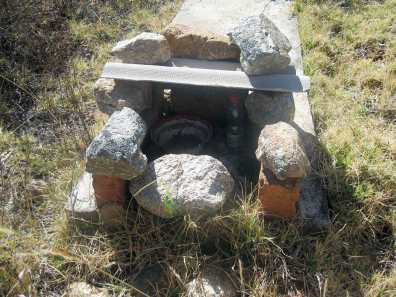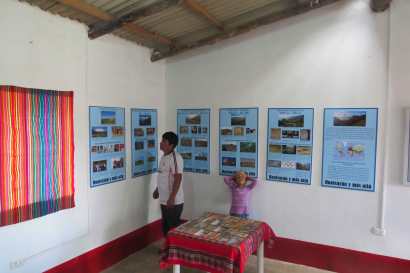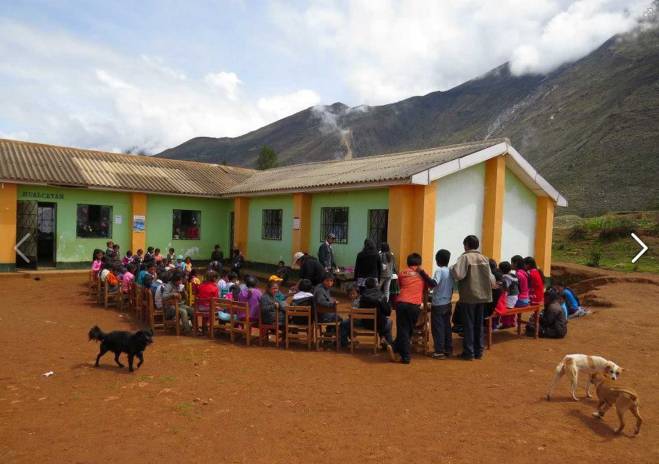For a Spanish language version of this post, click here
July 28th is Independence Day in Peru – and the day we presented the community copies of La Historia de Hualcayán: Contada Por Sus Pobladores the volume written by Elizabeth Cruzado Carranza based on oral histories collected by Hualcayán high school students in late 2014. I have blogged before about the project origins. In preparation for the event, Elizabeth and I thoroughly cleaned the courtyard area of the archaeology research complex and set out a long row of tables and chairs. The night before we peeled 72 kilos of potatoes and Sheyla Nuñuvero and her assistants prepared 15 chickens, salad and quite a few gallons of chicha morado.
 The event was a success. Eli and I were particularly happy that Leodan Abanto Alejo Valerio, who was responsible for launching the project, was able to attend and preside over the celebration. Consistent with being an outstanding educator, Leodan spoke eloquently and passionately about why such projects are important. He particularly focused on the educational role for the student oral historians in developing a sense of identity and pride in their community in both the Spanish and Quechua languages.
The event was a success. Eli and I were particularly happy that Leodan Abanto Alejo Valerio, who was responsible for launching the project, was able to attend and preside over the celebration. Consistent with being an outstanding educator, Leodan spoke eloquently and passionately about why such projects are important. He particularly focused on the educational role for the student oral historians in developing a sense of identity and pride in their community in both the Spanish and Quechua languages.

I spoke about the co-creative process. I noted that although Elizabeth and I had performed the technical publishing tasks and secured donations to fund the project, the essence of the volume was locally produced. That is, without the history verbally passed down over the years from community members, and passing that along to the student interviewers, the book would not have been possible. I also noted the uniqueness of the project – there is no other book of which we were aware in the Ancash region that tells a community’s history “contada por sus poladores.” The Hualcayán project is already viewed as model in one U.S. and two other Peruvian communities.
Elizabeth discussed her experience writing the book and presented a copy to every family in attendance. She noted that most of the copies would be placed in the school library consistent with Leodan’s expressed need for a classroom educational resource for students on their community history.

Several community residents spoke and expressed their thanks to the Hualcayán students who created the project and to Leodan for the original concept. Elizabeth and Rebecca Bria’s (Co-Directors of PIARA) friendship and long-term commitment to the community was also recognized by all of the residents who spoke. For example, even though pressed for time as she gathers data for her M.S. Thesis on a set of Hualcayán excavations, Elizabeth welcomes community children into the research complex every afternoon from 3:00 – 5:00 PM to watch videos on a laptop, draw, or other activities. She has spent many days, weeks and months over the past several years working in Hualcayán on archaeological and community based projects.
Here are some of my takeaways from the oral history book experience:
- The process worked. In a rural agricultural community like Hualcayán, where everyone works 7 days per week to sustain their existence (including on Independence Day) the oral history project is a small, but important contribution. “Importante” was the word most commonly used by the residents who spoke at the Independence Day event. They followed that statement up with examples on why knowing a community history is of value.
- We had a great discussion with Professor Abanto after the event and confirmed plans and responsibilities for completing another volume by next summer for the community where he is now assigned to teach – Huallanco. Leodan is one of several Ancash residents we encountered in the last year who collect oral histories – in some cases for many years. We view the Hualcayán volume not as a completed project, but as an example of the ongoing logistical support we can provide if a community has that expressed need. We have informally discussed with cultural heritage professionals and educators in the region the possibility of establishing something like an Ancash Region Oral History Program. That may happen one day, but the impetus for moving on the project will come from the Ancash communities.
- Oral history is something we are prepared to support at the museums Elizabeth and I visited in both Nivín and Caraz this summer. However, an expressed need in both of these museums was for Spanish language documents on collections management – not part of our initial plan. Within 48 hours we were able to use our resources and networks to acquire an abundance of these materials.
- As cultural heritage professionals, in this way we can create value in a co-created relationship. At the museum and site at Nivín, Professor Valencia’s interest is less in our organizing field crews to excavate the Nivín site and find cool stuff for the museum. Rather the need Professor Valencia clearly stated was to train the Nivín students in the proper methods for curating materials and preserving a site that is of little apparent interest to the professional archaeological community but is being impacted by both agricultural and looting activities.
The above lead me to my “go to” snippets for what I mean by co-creation and applied archaeology:
Learn what aid the community needs: fit the museum to those needs. John Cotton Dana, The New Museum, 1917
. . . the act of engagement with others who are trying to make decisions related to particular heritage resources. Erve Chambers 2004:194
Working together or diversifying audiences is not enough. What is needed are reciprocal, co-created relationships that connect the assets and purposes of organizations. Elizabeth Hirzy 2002
To give voice and be responsive to the needs and interests of local community members; to provide a place for community engagement and dialogue; and to help participants develop skills that will support their own individual and community goals. – Nina Simon 2010:187
To this end, our field season this year in Peru is going quite well.

















